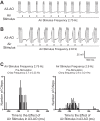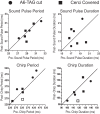Impact of cercal air currents on singing motor pattern generation in the cricket (Gryllus bimaculatus DeGeer)
- PMID: 26334014
- PMCID: PMC4643095
- DOI: 10.1152/jn.00669.2015
Impact of cercal air currents on singing motor pattern generation in the cricket (Gryllus bimaculatus DeGeer)
Abstract
The cercal system of crickets detects low-frequency air currents produced by approaching predators and self-generated air currents during singing, which may provide sensory feedback to the singing motor network. We analyzed the effect of cercal stimulation on singing motor pattern generation to reveal the response of a singing interneuron to predator-like signals and to elucidate the possible role of self-generated air currents during singing. In fictive singing males, we recorded an interneuron of the singing network while applying air currents to the cerci; additionally, we analyzed the effect of abolishing the cercal system in freely singing males. In fictively singing crickets, the effect of short air stimuli is either to terminate prematurely or to lengthen the interchirp interval, depending on their phase in the chirp cycle. Within our stimulation paradigm, air stimuli of different velocities and durations always elicited an inhibitory postsynaptic potential in the singing interneuron. Current injection in the singing interneuron elicited singing motor activity, even during the air current-evoked inhibitory input from the cercal pathway. The disruptive effects of air stimuli on the fictive singing pattern and the inhibitory response of the singing interneuron point toward the cercal system being involved in initiating avoidance responses in singing crickets, according to the established role of cerci in a predator escape pathway. After abolishing the activity of the cercal system, the timing of natural singing activity was not significantly altered. Our study provides no evidence that self-generated cercal sensory activity has a feedback function for singing motor pattern generation.
Keywords: air stimulus; cercal sensory system; escape response; singing central pattern generator interneuron.
Copyright © 2015 the American Physiological Society.
Figures







Similar articles
-
Corollary discharge inhibition of wind-sensitive cercal giant interneurons in the singing field cricket.J Neurophysiol. 2015 Jan 1;113(1):390-9. doi: 10.1152/jn.00520.2014. Epub 2014 Oct 15. J Neurophysiol. 2015. PMID: 25318763 Free PMC article.
-
Control of cricket stridulation by a command neuron: efficacy depends on the behavioral state.J Neurophysiol. 2000 Feb;83(2):712-22. doi: 10.1152/jn.2000.83.2.712. J Neurophysiol. 2000. PMID: 10669487
-
Feedforward discharges couple the singing central pattern generator and ventilation central pattern generator in the cricket abdominal central nervous system.J Comp Physiol A Neuroethol Sens Neural Behav Physiol. 2019 Dec;205(6):881-895. doi: 10.1007/s00359-019-01377-7. Epub 2019 Nov 5. J Comp Physiol A Neuroethol Sens Neural Behav Physiol. 2019. PMID: 31691096 Free PMC article.
-
Computational mechanisms of mechanosensory processing in the cricket.J Exp Biol. 2008 Jun;211(Pt 11):1819-28. doi: 10.1242/jeb.016402. J Exp Biol. 2008. PMID: 18490398 Review.
-
Neuroethology of acoustic communication in field crickets - from signal generation to song recognition in an insect brain.Prog Neurobiol. 2020 Nov;194:101882. doi: 10.1016/j.pneurobio.2020.101882. Epub 2020 Jul 13. Prog Neurobiol. 2020. PMID: 32673695 Review.
Cited by
-
Structure, Activity and Function of a Singing CPG Interneuron Controlling Cricket Species-Specific Acoustic Signaling.J Neurosci. 2019 Jan 2;39(1):96-111. doi: 10.1523/JNEUROSCI.1109-18.2018. Epub 2018 Nov 5. J Neurosci. 2019. PMID: 30396914 Free PMC article.
-
Modular timer networks: abdominal interneurons controlling the chirp and pulse pattern in a cricket calling song.J Comp Physiol A Neuroethol Sens Neural Behav Physiol. 2020 Nov;206(6):921-938. doi: 10.1007/s00359-020-01448-0. Epub 2020 Oct 21. J Comp Physiol A Neuroethol Sens Neural Behav Physiol. 2020. PMID: 33089402 Free PMC article.
-
Behavioural integration of auditory and antennal stimulation during phonotaxis in the field cricket Gryllus bimaculatus.J Exp Biol. 2016 Nov 15;219(Pt 22):3575-3586. doi: 10.1242/jeb.141606. Epub 2016 Sep 8. J Exp Biol. 2016. PMID: 27609761 Free PMC article.
References
-
- Andersson O, Forssberg H, Grillner S, Wallén P. Peripheral feedback mechanisms acting on the central pattern generators for locomotion in fish and cat. Can J Physiol Pharmacol 59: 713–726, 1981. - PubMed
-
- ASAB Ethics Committee. Guidelines for the treatment of animals in behavioural research and teaching. Anim Behav 71: 245–253, 2006. - PubMed
-
- Baba Y, Shimozawa T. Diversity of motor responses initiated by a wind stimulus in the freely moving cricket, Gryllus bimaculatus. Zoolog Sci 14: 587–594, 1997.
-
- Bässler U. Afferent control of walking movements in the stick insect Cuniculina impigra. J Comp Physiol A 158: 351–362, 1986.
-
- Bellman KL, Krasne FB. Adaptive complexity of interactions between feeding and escape in crayfish. Science 221: 779–781, 1983. - PubMed
Publication types
MeSH terms
Grants and funding
LinkOut - more resources
Full Text Sources
Other Literature Sources

